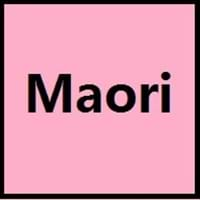Cebuano vs Maori
Countries
Philippines
New Zealand
National Language
Philippines
New Zealand
Second Language
Philippines
Not spoken in any of the countries
Speaking Continents
Asia
Australia, Oceania
Minority Language
Not spoken in any of the countries
Not spoken in any of the countries
Regulated By
Visayan Academy of Arts and Letters
Māori Language Commission
Interesting Facts
- About one-fifth of the population of the philippines speak cebuano and are second largest ethnolinguistic group in the country.
- Cebuano contains many words of Spanish origin.
- "E korao no New Zealand" was the first printed Maori book in 1815.
- The first newspaper in the Maori language was published in year 1842.
Similar To
Hiligaynon Language
Tahitian Language
Derived From
Island of Cebu
Not Available
Alphabets in
Cebuano-Alphabets.jpg#200
Maori-Alphabets.jpg#200
Writing Direction
Not Available
Not Available
Thank You
Salamat
Mauruuru koutou
How Are You?
Kumusta man ka?
E pēhea ana koe ?
Good Night
Maayong Gabii
Night pai
Good Evening
Maayong Gabii
pai ahiahi
Good Afternoon
Maayong Hapon
Afternoon pai
Good Morning
Maayong Buntag
Morning pai
Sorry
Ikasubo ko
Aroha mai
I Love You
Gihigugma ko ikaw
Aroha ahau ki a koe
Excuse Me
Ekskyus mi
tukua ahau
Dialect 1
Boholano
South Island Māori
Where They Speak
Bohol
New Zealand
Dialect 2
Southern Kana
Western North Island Maori
Where They Speak
southern Leyte
New Zealand
Dialect 3
North Kana
Eastern North Island Maori
Where They Speak
northern part of Leyte
New Zealand
How Many People Speak?
Not Available
Speaking Population
Not Available
Second Language Speakers
Not Available
Native Name
Visayan
te Reo Māori
Alternative Names
Binisaya, Bisayan, Sebuano, Sugbuanon, Sugbuhanon, Visayan
New Zealand Maori
French Name
cebuano
maori
German Name
Cebuano
Maori-Sprache
Pronunciation
Not Available
Not Available
Ethnicity
Cebuano people
Māori people
Language Family
Austronesian Family
Austronesian Family
Subgroup
Not Available
Polynesian
Branch
Not Available
Not Available
Early Forms
No early forms
No early forms
Standard Forms
Standard Cebuano
Maori
Language Position
Not Available
Signed Forms
Not Available
Not Available
Scope
Individual
Individual
ISO 639 1
No data Available
mi
ISO 639 6
Not Available
Not Available
Glottocode
cebu1242
maor1246
Linguasphere
No data Available
No data Available
Language Type
Living
Living
Language Linguistic Typology
Verb-Subject-Object
Not Available
Language Morphological Typology
Not Available
Not Available
Cebuano and Maori Language History
Comparison of Cebuano vs Maori language history gives us differences between origin of Cebuano and Maori language. History of Cebuano language states that this language originated in 16th century whereas history of Maori language states that this language originated in 1814. Family of the language also forms a part of history of that language. More on language families of these languages can be found out on Cebuano and Maori Language History.
Cebuano and Maori Greetings
People around the world use different languages to interact with each other. Even if we cannot communicate fluently in any language, it will always be beneficial to know about some of the common greetings or phrases from that language. This is where Cebuano and Maori greetings helps you to understand basic phrases in Cebuano and Maori language. Cebuano word for "Hello" is Hoy or Maori word for "Thank You" is Mauruuru koutou. Find more of such common Cebuano Greetings and Maori Greetings. These greetings will help you to be more confident when conversing with natives that speak these languages.
Cebuano vs Maori Difficulty
The Cebuano vs Maori difficulty level basically depends on the number of Cebuano Alphabets and Maori Alphabets. Also the number of vowels and consonants in the language plays an important role in deciding the difficulty level of that language. The important points to be considered when we compare Cebuano and Maori are the origin, speaking countries, language family, different greetings, speaking population of these languages. Want to know in Cebuano and Maori, which language is harder to learn? Time required to learn Cebuano is 3 weeks while to learn Maori time required is 24 weeks.





